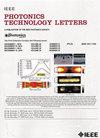Single-Cavity Dual-Comb Fiber Laser Enabled Pump-Probe Microscopy
IF 2.3
3区 工程技术
Q2 ENGINEERING, ELECTRICAL & ELECTRONIC
引用次数: 0
Abstract
Pump-probe technique is an important spectroscopic method for characterizing photocarrier dynamics in semiconductors. When combined with fast scanning mechanisms, pump-probe spectroscopy can yield spatially relevant information and is highly desirable for advanced characterization of materials. A conventional pump-probe microscopy system requires an optical delay-line to vary the time delay between the pump and the probe pulses, which poses a significant bottleneck for the imaging speed. Thanks to the method of asynchronous optical sampling, the data acquisition speed in a pump-probe measurement can be dramatically improved by using dual-comb light sources. However, commercially available dual-comb sources are bulky systems with complicated stabilization mechanisms, making their wide use in pump-probe imaging systems a challenge. In this letter, we demonstrate a pump-probe microscopy system enabled by a single-cavity dual-comb Er-doped fiber laser for the first time. The single-point data acquisition time is reduced to less than 6 ms. By using this single-cavity dual-comb source, an InGaAs quantum-well sample with millimeter lateral dimension has been characterized, and meaningful images showing surface defective sites are clearly presented. These results provide a new solution for fast and cost-effective pump-probe imaging systems.求助全文
约1分钟内获得全文
求助全文
来源期刊

IEEE Photonics Technology Letters
工程技术-工程:电子与电气
CiteScore
5.00
自引率
3.80%
发文量
404
审稿时长
2.0 months
期刊介绍:
IEEE Photonics Technology Letters addresses all aspects of the IEEE Photonics Society Constitutional Field of Interest with emphasis on photonic/lightwave components and applications, laser physics and systems and laser/electro-optics technology. Examples of subject areas for the above areas of concentration are integrated optic and optoelectronic devices, high-power laser arrays (e.g. diode, CO2), free electron lasers, solid, state lasers, laser materials'' interactions and femtosecond laser techniques. The letters journal publishes engineering, applied physics and physics oriented papers. Emphasis is on rapid publication of timely manuscripts. A goal is to provide a focal point of quality engineering-oriented papers in the electro-optics field not found in other rapid-publication journals.
 求助内容:
求助内容: 应助结果提醒方式:
应助结果提醒方式:


